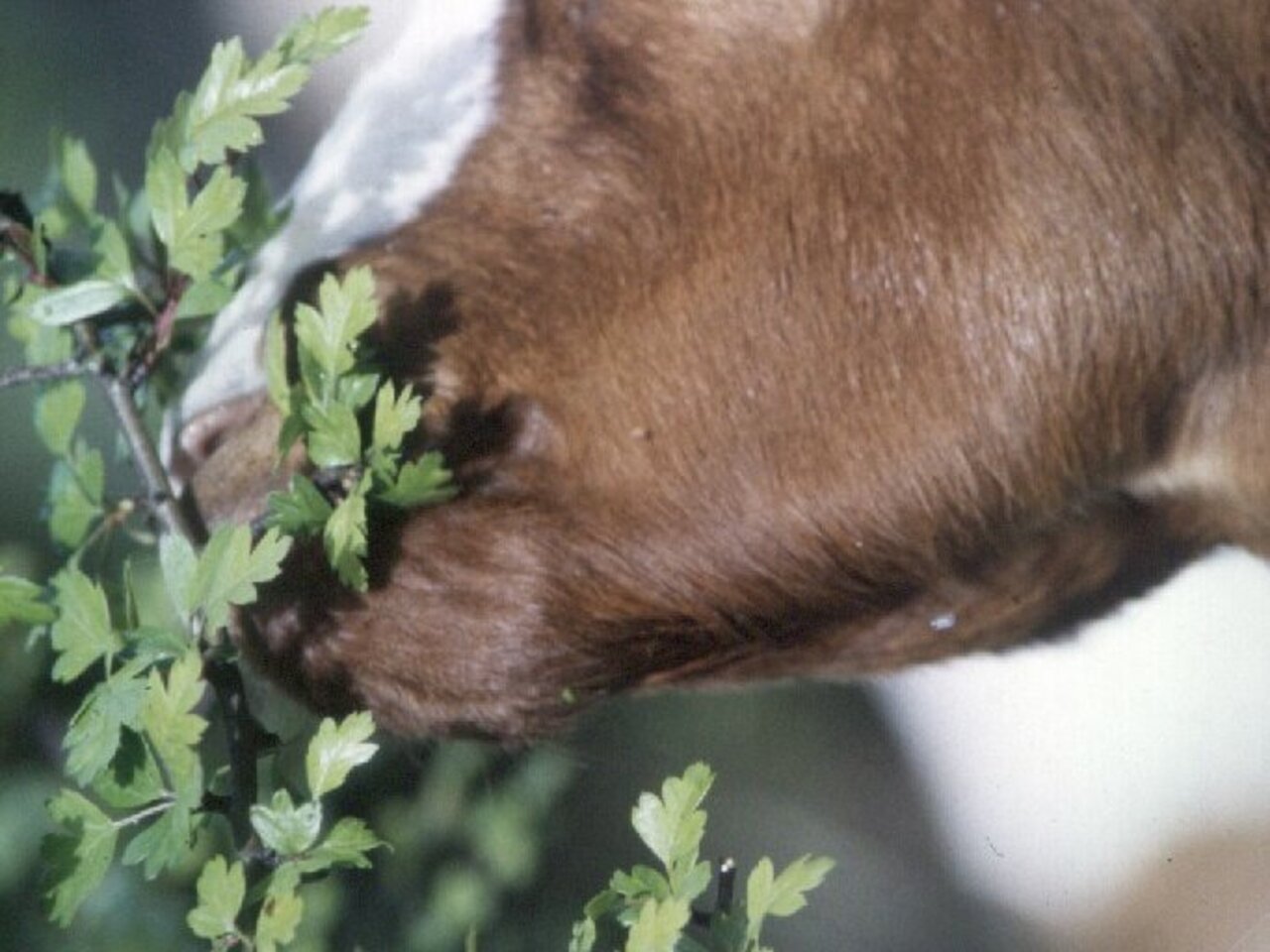Project
Shrub control with goats in protected biotopes

Biotope management with goats and sheep
The usage of goats for biotope management has been increased in the last 20 years. As part of a sheep herd or even as a pur goat herd they can help to prevent shrub invasion.
Background and Objective
Many agri-cultural landscapes in Europe are created by sheep. Due to the fact of intensification and abandance of livestock, many of the biotopes are endangered and protected as nature reserverse. They need grazing / browsing by sheep or goats to prevent the invasion of shrubs and high grass cover.
Particularly goats can help to control shrubs.
Goats can tolerate a big proportion of leafs in their diet, like to climb and can even reach feed, where sheep, other livestock or machines have difficulties. With their special browsing behavior they can select good fodder in marginal environments.
At the Thünen-Institute of Organic Farming special questions have been further elaborated, particularly the fodder value of shrub leafs, the behavior of goats in shrub dominated environments and the utilisation of kids without mother in biotop management have been developed.
Goal of the research was the development of practicable systems of biotop management, which a) reach the goals (shrub control, prevention and improvement of the biotop-indicators), b) are economically for the society (costs of biotop management) and profitable for the animal holder), and c) be acceptable for animal welfare (health, productivity, behavior).
Approach
The system of biotop management with goats was developed by Prof. Dr. Gerold Rahmann at the University of Kassel in the 90s.
At the Thünen-Institute of Organic Farming open questions left in the system development have been answered: feeding values, grazing/browsing behavior, special system approaches. The dairy goat herd on the experimental station in Trenthorst as well as pratice farms throughout Germany have been used for the research.
Results
- Goats can be used for biotop management up to a level of 60% shrub invasion.
- The fences should be wire and nets. The fence power should have 6000 V.
- Meat breeds (Bure goats) or crosses between milk and meat goat breeds should be used. Pure breed milk breeds suffer due to limited fodder availability and quality.
- Suckling lambs should be done. They can gain 100-150 g per day.
- Goat keeping can reduce the biotop maintenance costs considerably (50-75%).
- The management schemes must pay the difference between ordinary profitability and reduce biotope profitabilities (about 350 Euro/ha and year in Germany).
- The deforestation with goats needs 3-5 years.
- Manual cleaning has to be added. Roughly 10 h per ha and year with a motor trimmer.
- Parasite and weather conditions have to be controlled to keep livestock healthy.
- Leafes of shrubs can have high quality of nutrients (up to 20-30% of protein, high rate of minerals) and are liked by goats.
- The digestion of leafs is low (below 60%), but depends on seasonal status.
Thünen-Contact

Prof. Dr. agr. habil. Gerold Rahmann
Involved Thünen-Partners
Involved external Thünen-Partners
- Universität Kassel
(Kassel, Witzenhausen, Deutschland)
Funding Body
-
Bundesland Hessen
(national, öffentlich) -
European Union (EU)
(international, öffentlich)
Duration
7.1993 - 12.2012
More Information
Funding program: EU - COST Action
Project status:
finished
Publications
- 0
Georg H, Bender S, Ude G (2013) Anwendung eines Systems zur automatischen Verhaltenserfassung von Ziegenlämmern bei der "Beweidung" von Futtergehölzen. In: Neuhoff D, Stumm C, Ziegler S, Rahmann G, Hamm U, Köpke U (eds) Beiträge zur 12. Wissenschaftstagung Ökologischer Landbau : Ideal und Wirklichkeit: Perspektiven ökologischer Landbewirtschaftung . Berlin: Köster, pp 560-563
- 1
Börner W, Ude G, Bender S, Georg H (2013) Beweidung von Futterhecken mit Ziegenlämmern. Landbauforsch Appl Agric Forestry Res 63(1):69-78, DOI:10.3220/LBF_2013_69-78
https://literatur.thuenen.de/digbib_extern/bitv/dn051737.pdf
- 2
Georg H, Ude G, Bender S (2012) Automatisierte Erfassung des Weideverhaltens von Ziegenlämmern mithilfe eines Echtzeit-Positionierungssystems. KTBL Schr 496:225-226
- 3
Ude G, Börner W, Bender S, Georg H (2011) Untersuchung zur Beäsung von Futterhecken mit Ziegenlämmern. Landbauforsch SH 346:77-90
- 4
Koopmann R (2011) Untersuchungen zur Wirksamkeit von Eichenrinde zur Entwurmung von Jungziegen. Tierärztl Umsch 66(5):210-212
- 5
Rahmann G (2009) Ökologische Schaf- und Ziegenhaltung : 100 Fragen und Antworten für die Praxis. 2., überarb. Aufl. Braunschweig: FAL, 261 p
- 6
Koopmann R (2009) Parasitenmanagement beim Weidegang von Ziegen. Landbauforsch SH 332:97-101
- 7
Rahmann G (2008) Maintenance of protected biotopes in Germany by goats keeping. In: Proceedings of the 9th International Conference on Goats : "Sustainable Goat Production: Challenges and Opportunities of Small and Large Enterprises" ; Querétaro, México, August 31st - September 4th, 2008. p 100
- 8
Rahmann G (2008) Naturschutz mit Schafen und Ziegen. Landbauforsch SH 320:11-26
- 9
Rahmann G, Seip H (2007) Alternative management strategies to prevent and control endo-parasite diseases in sheep and goat farming systems - a review of the recent scientific knowledge. Landbauforsch Völkenrode 57(2):193-206
https://literatur.thuenen.de/digbib_extern/bitv/dk038232.pdf
- 10
Rahmann G, Seip H (2007) Bioactive forage and phytotherapy to cure and control endo-parasite diseases in sheep and goat farming systems - a review of current scientific knowledge. Landbauforsch Völkenrode 57(3):285-295
https://literatur.thuenen.de/digbib_extern/bitv/dk038397.pdf
- 11
Rahmann G, Koopmann R, Gutperlet J (2007) Die Wirkung der Fütterung von Haselnussblättern auf die Ausscheidung von Magen-Darm-Strongylideneiern bei Ziegen. In: Zikeli S, Claupein W, Dabbert S (eds) Beiträge zur 9. Wissenschaftstagung Ökologischer Landbau "Zwischen Tradition und Globalisierung" : Universität Hohenheim, 20.-23. März 2007 ; Bd. 2. Berlin: Köster, pp 649-652
- 12
Rahmann G (2007) Extensive Standorte : Grenzen, Möglichkeiten und Gefahren. In: Rahmann G, Schumacher U, Reinmuth B (eds) 2. Internationale Bioland Schaf- und Ziegentagung - Schlüssel zum Erfolg, 27.-28. November 2007 in Herrsching : Tagungsreader. pp 21-33
- 13
Rahmann G (2004) Utilisation and maintenance of indigenous shrubs in protected open grassland (Gentiano-Koelerietum) by organic goats keeping. Landbauforsch Völkenrode 54(1):45-50
https://literatur.thuenen.de/digbib_extern/bitv/zi032850.pdf

![[Translate to English:] [Translate to English:]](/media/_processed_/8/e/csm_Bildschirmfoto_2021-03-03_bearb_fc48ac88bf.jpeg)
![[Translate to English:] [Translate to English:]](/media/_processed_/8/e/csm_Bildschirmfoto_2021-03-03_bearb_ba3ec0e9d7.jpeg)





